-
Paper Information
- Paper Submission
-
Journal Information
- About This Journal
- Editorial Board
- Current Issue
- Archive
- Author Guidelines
- Contact Us
International Journal of Agriculture and Forestry
p-ISSN: 2165-882X e-ISSN: 2165-8846
2020; 10(1): 1-10
doi:10.5923/j.ijaf.20201001.01

Water Use Efficiency of Smallholder Farmers’ Irrigation Scheme and Its Consequences on Lake Hawassa
Yadeta Teshome Negasa
Lecturer at Wondo Genet College, Ethiopia
Correspondence to: Yadeta Teshome Negasa, Lecturer at Wondo Genet College, Ethiopia.
| Email: |  |
Copyright © 2020 The Author(s). Published by Scientific & Academic Publishing.
This work is licensed under the Creative Commons Attribution International License (CC BY).
http://creativecommons.org/licenses/by/4.0/

The research was conducted in Hawassa watershed around Lake Hawassa during 2019. Cultivation near the lake and over-pumping of Lake Hawassa water for irrigation has initiated the research. Analysis of smallholder farmers’ irrigation schemes WUE and its consequences on Lake Hawassa were the objectives addressed. Regular field observations into irrigation schemes and measurements’ made into WUE indicative parameters while smallholder farmers’ irrigate their crops has been generated the core research data. Water applied into the field and moisture stored in the soil both before and after irrigation was determined empirically and gravimetrically. Additional data regarding socioeconomic aspects of irrigation was collected from focus group discussion. Excel Microsoft word, CROPWAT 8 and ArcGIS were used to analyze data, and produce figures. The soil texture of the study area was dominated by sandy loam with large percolation loss of water resulted in poor application efficiency. The irrigation water pumped was three-fold higher than the required. Overall irrigation scheme efficiency was very poor (38%). Chemicals used for crop growth and healthy purpose were washed into the lake during the rainy season with sediments carried on from upper cultivated lands. Therefore, to prevent lake water from deterioration the irrigation water sources should be replaced by harvested water or/and well water. If not a mode of water application needs to be modified into drip irrigation. For these the government body and NGOs should be aware the smallholder farmers about problems of irrigation on the lake and provide all the necessary support to sustain it.
Keywords: Dependency on lake water, Poverty, Furrow method, Over-pumping, WUE
Cite this paper: Yadeta Teshome Negasa, Water Use Efficiency of Smallholder Farmers’ Irrigation Scheme and Its Consequences on Lake Hawassa, International Journal of Agriculture and Forestry, Vol. 10 No. 1, 2020, pp. 1-10. doi: 10.5923/j.ijaf.20201001.01.
Article Outline
1. Introduction
- Lake Hawassa is one of the Ethiopian main rift valley lakes over which precipitation is the only fresh water very limited to certain months. Access to sufficient water for irrigation is the basic need that affects socio-economic enhancement and expose the lake to pollution (Worako, 2015). Food shortage which made survival of farmers complex have resulted due to dense population derived by small landholding, irregularity and total dependency on rainfall and lack of perennial stream flow has initiated intensive use of Lake Hawassa water for supplemental irrigated agriculture. Irrigation based agriculture especially smallholder farmers’ schemes are the top users of water (Howell, 2001). Prevalence of drought, sedimentation in natural lakes of Ethiopia due to intensive cultivation around the lakes has been affecting capacity of lakes (Alemayehu et al., 2007.); chronic poverty prevailing in sub-Saharan Africa needs promising use of irrigation (Gebrehiwot and Gebrewahid, 2016). The overriding problem shall be total dependence on agriculture, intensive cultivation near the shore lake, losses/misuse of irrigation water and lack of knowledge/advice. These problems are aggressive to bring farreaching negative effect on water users and overall development of the country. Smallholder farmers’ of developing countries (definitely Ethiopia) are highly dependent on natural resource exploitation in destructive ways. Water in the lake and adjacent lands (lake shores) are the main resources under pressure. Now a day irrigation water scarcity is the main concern for more portions of Ethiopian surface dry land. Extraordinary pressure is exerted on available water resources due to increasing demand for food (Howell, 2001, Golzardi et al., 2017 and Teshome et al., 2018). Thus, even if over-pumping of lake water was not recommendable for adjacent land cultivation; efficient water use and sufficient buffer zone were very crucial in study area. Onion, head cabbage and tomato are among vegetables being produced around the lake as to most Ethiopian irrigated lands as source of income and food at different levels (Hunde, 2017). Natural lakes and rivers were the pillar water supply sources for irrigated agriculture. Rising demand for water and over-pumping of lake water will lead to diminishing in lake water quantity, deteriorated food security and constrain economic development (Alemayehu et al., 2007). WUE of irrigated agriculture in most cases were enhanced by on-farm irrigation technology. Reduced irrigation water loss and increased WUE sustains water supply potential of the water sources. Agriculture consumes more than eighty percent of the worlds developed water supplies (Howell, 2001). Even if underground pipes were used to transport water into farm land mode of water distribution within the field strongly enhances water loss. Thus, it was said that gravity based traditional schemes has only 40% efficiency (Seckler, 1996); which means that 60% of diverted water was lost with related consequences. WUE contain any measure that reduces the amount of water used per unit of any given activity (Gebremariam et al., 2018 and Hamdy, 2007). WUE has been major challenge in irrigation scheme. Sustainable water supply technique and effective watering approaches are pressing need (Taddese and Peden, 2001 and Teshome et al., 2018). Adequate dosage of irrigation water maximize crop production and rise WUE for future purposes (Taddese and Peden, 2001) with the aim of keeping water level in the root zone within a range where crop yield and quality are not damaged due to either inadequate or excess watering. Thus, capable use and appropriate allocation of irrigation water are energetic for durability of cultivation in water scarce areas. However, irrigation water use has been dared by many factors including quantity and accessibility of water, types of crop grown, struggle in sharing water and mode of application. Therefore, the research was aimed to address the following objectives:× To analyze (crop water requirement) CWR of more commonly produced field crops by CROPWAT 8.× To determine supplemental irrigation WUE at smallholder farmers level located around Lake Hawassa thorough water measurement at pipe outlet and field inlet points across areas, water delivery potentials of the scheme and output of the scheme × To determine selective physical properties of soils whether it contributes for water loss and irrigation inefficiency. × To examine consequences of irrigated agriculture on Lake Hawassa. × To execute socioeconomic aspects of irrigation water used via focus group discussion (FGD) encompassing development agents and irrigators located across Lake Hawassa.
2. Methodology
- Description and irrigated map of study areaThe area under supplemental irrigation is located towards the western side of Lake Hawassa and Hawassa city figure 2. It is closely adjacent unto the lake which means no buffer zone in between the two. Geo referenced GPS points overlaid on google earth has utilized to generate study area map and related data. The overall perimeter of the lake was 53235 m. Body contacts of features such as irrigated land, Hawassa town (settlements), natural features (forests, mountains) boundary in touch with the lake were 29665, 13956 and 9614 m respectively. The core point of this research, irrigated land is bordered with the lake shore line by about 56%. Such kind of proximity has created everlasting opportunity for surrounding smallholder farmers’ and investors of ease Lake water pumping using motor with buried pipes unto irrigated lands. Weather data analysed over fifteen consecutive years indicated that areas near Hawassa city receives mean annual temperature of 19.79°C and mean annual precipitation of 944 mm per year. The study area has three major seasons. The first is long rainy season occurs between June to September called summer with annual total precipitation 50-70% locally called kiremt. Second is dry period that happens in between October and February locally called bega and the third is short rainy season takes place during March and May locally called belg when 20-30% of the precipitations occur (Halcrow, 2010). Mean monthly precipitation between April and September be beyond 105 mm with 128.8 mm in August and the lowest precipitation occurred in November, December, January and February. figure 1.
 | Figure 1. Monthly precipitation averaged over 2000-2015 at Hawassa watershed |
 | Figure 2. Irrigated and study area map |
 | (1) |
 | (2) |
 | (3) |
 | (4) |
 | (5) |
 | (6) |
 | (7) |
 - soil water content on a dry weight basis in % Ww - wet weight of the soil, gm; Wd - dry weight of the soil, gm. The weather data collected form national meteorological agency encompasses precipitation, relative humidity, sunshine hours, wind speed, minimum and maximum temperature on daily bases has been analyzed by CROPWAT 8. Various methods have been developed to compute reference crop evapotranspiration. Thus, the most accurate and complex method was the Penman-Monteith method as presented by (Allen, 1986). Radiation and advection are both considered in the method. Studies have shown that the Penman-Monteith method is more reliable for any length period than methods that use less weather data (Jensen et al., 1990). The method works well for daily calculations and for estimating monthly or seasonal water needs. The crop coefficients were assimilated from (FAO, 2006).
- soil water content on a dry weight basis in % Ww - wet weight of the soil, gm; Wd - dry weight of the soil, gm. The weather data collected form national meteorological agency encompasses precipitation, relative humidity, sunshine hours, wind speed, minimum and maximum temperature on daily bases has been analyzed by CROPWAT 8. Various methods have been developed to compute reference crop evapotranspiration. Thus, the most accurate and complex method was the Penman-Monteith method as presented by (Allen, 1986). Radiation and advection are both considered in the method. Studies have shown that the Penman-Monteith method is more reliable for any length period than methods that use less weather data (Jensen et al., 1990). The method works well for daily calculations and for estimating monthly or seasonal water needs. The crop coefficients were assimilated from (FAO, 2006). 3. Results and Discussions
- Physical properties of soils near the LakeSoil sample analysis conducted in Wondo Genet College of Forestry and Natural Resources laboratory has generated indicative soil physical properties. Texture, soil moisture and bulk density of soils were determined that such properties potentially show whether irrigation water loss and inefficiency exists. Irrespective of soil textural class the soil moisture across crop types and within the crop were different figure 3. Comparatively slight consistent moisture content was observed under tomato crop due to the fact that good basal area coverage and leaf fall which minimizes evaporative water loss than onion and head cabbage. Sandy loam subjected soils have low water holding capacity than other textures (Howell, 2001 and Teshome et al., 2018). Bulk density of such soils shows similarity across crop types. Uniformity in bulk density values has been reflected more due to similarity in soil textural classes (75% of the total samples is sandy loam) figure 3. Dominance in sandy loam shows low moisture content with high percolation losses in the study area.
 | Figure 3. Physical property of soils in study area |
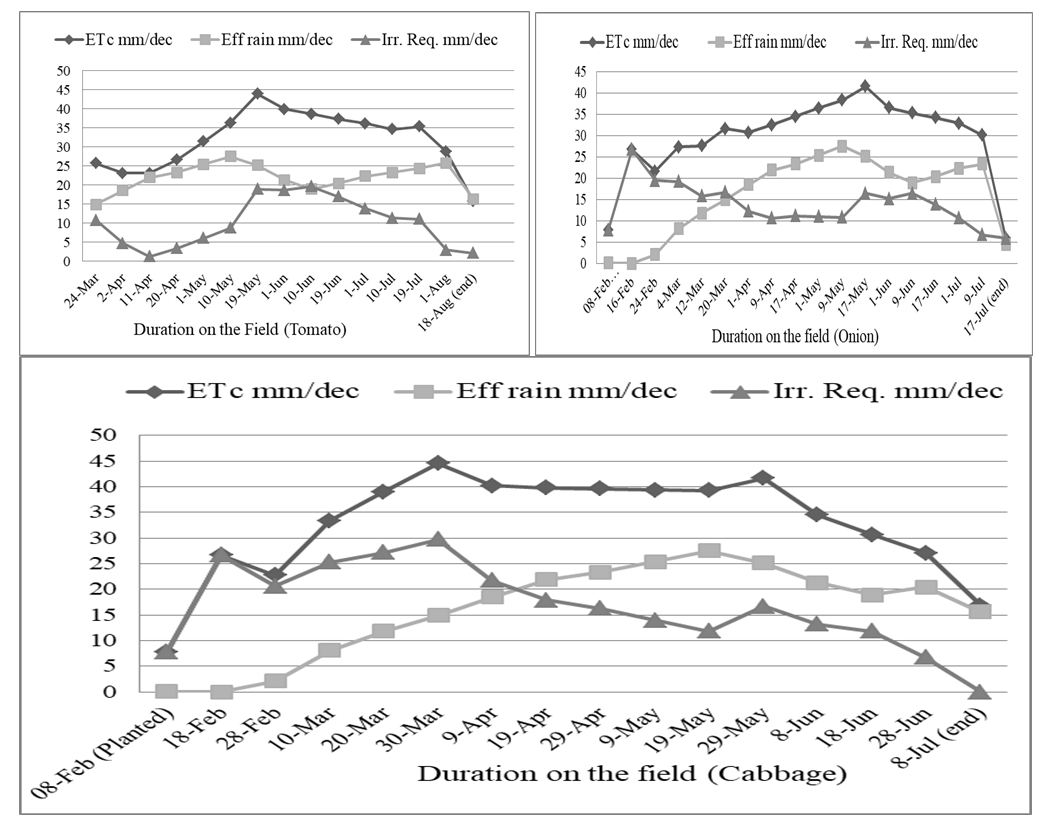 | Figure 4. CWR of field crops using CROPWAT 8 in study area |
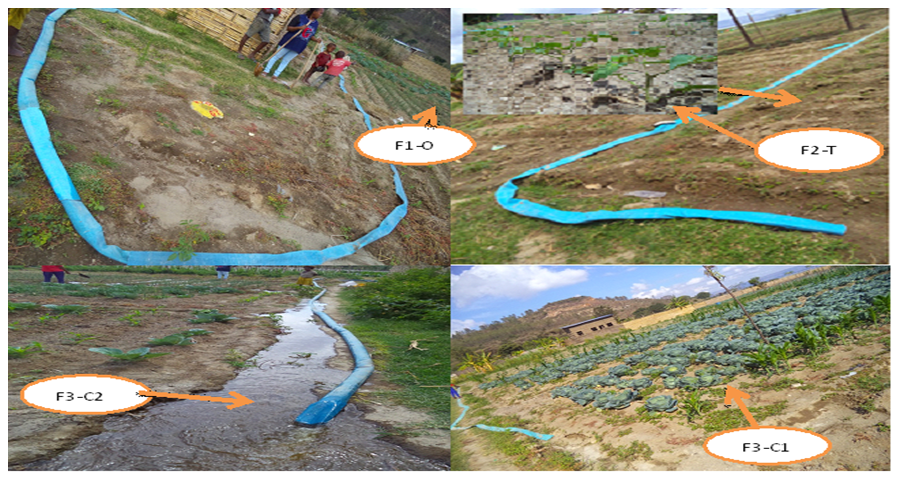 | Figure 5. Irrigation water delivery scheme from Lake Hawassa |
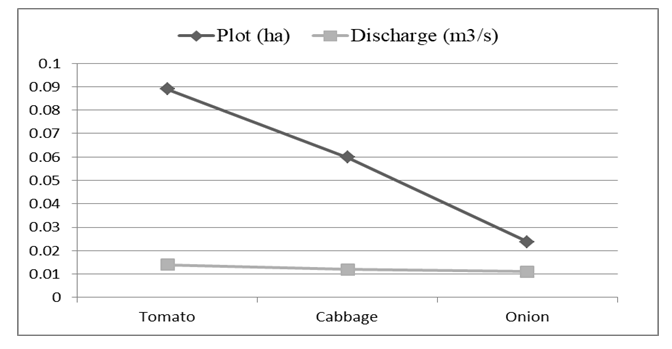 | Figure 6. Irrigation water application rate as practiced by farmers |
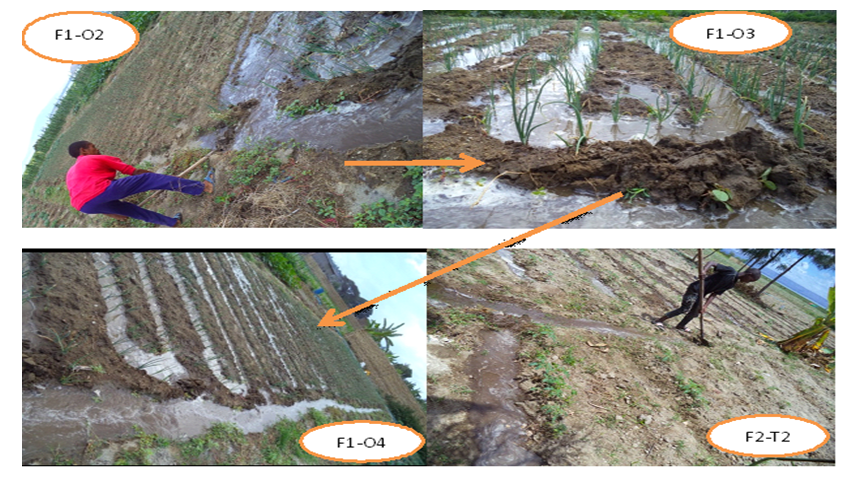 | Figure 7. Infield irrigation water distribution as practiced by smallholder farmers’ |
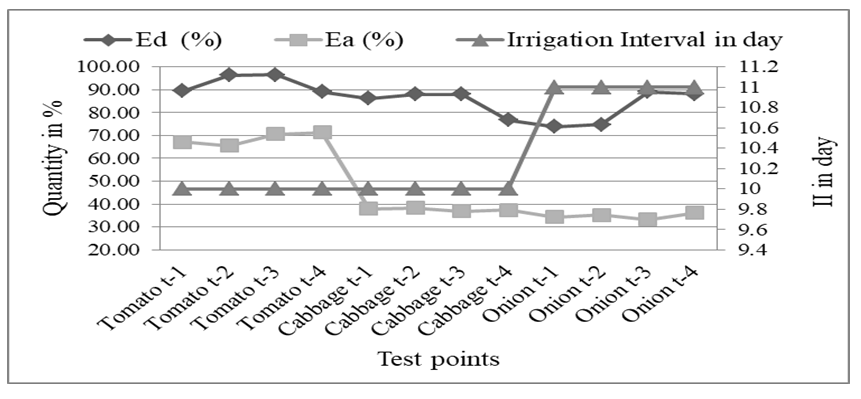 | Figure 8. Irrigation water use efficiency |
|
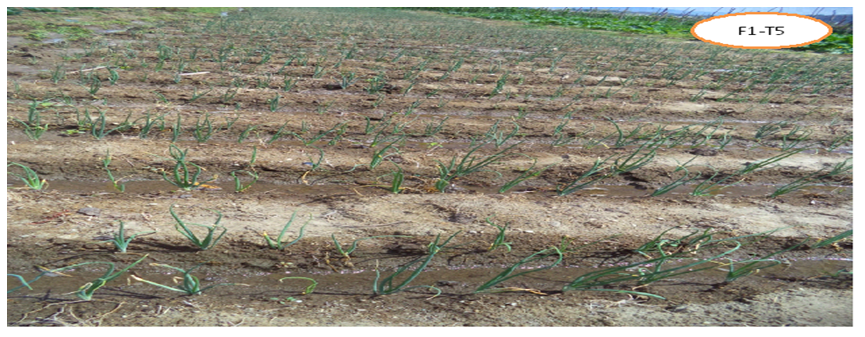 | Figure 9. Moisture condition soon after irrigation water cutoff |
4. Conclusions and Recommendations
- The irrigated land and the lake were fussed; no buffer zone between the two. Tomato, head cabbage and onion were the main vegetables produced under supplemental irrigation by furrow method of water application. The irrigation water distribution method in use with the soil textures has allowed large percolation loss. Lake Hawassa water was over pumped than required (about three-fold of the required water) due to irrigation; contributing for lake capacity reduction especially during the dry period of the year. Lack of Lake buffer zone and prevalence of chemical application and sediment carried on during the rainy season resulted in further lake water quality deterioration. The smallholder farmers’ of the study area was strongly dependent on lake water due to challenges of life/poverty. To save the lake water from deterioration the irrigation water sources should be replaced by harvested water or/and well water. If not, the mode of water application needs to be modified into drip irrigation. The government body and NGOs should capacitate the smallholder farmers’ about problems of irrigation on the lake and provide all the necessary support which sustains Lake Hawassa water from deterioration.
Ethical Statement
- I testify that my article submitted to applied water science entitled “Water Use Efficiency of Smallholder Farmers’ Irrigation Scheme and Its Consequences on Lake Hawassa.”Author:1) this material has not been published in the whole or in part elsewhere;2) the manuscript is not currently being considered for publication in another journal;3) I have been personally and actively involved in substantive work leading to the manuscript and will hold myself individually responsible for content.Date: 05/12/2019
 Abstract
Abstract Reference
Reference Full-Text PDF
Full-Text PDF Full-text HTML
Full-text HTML